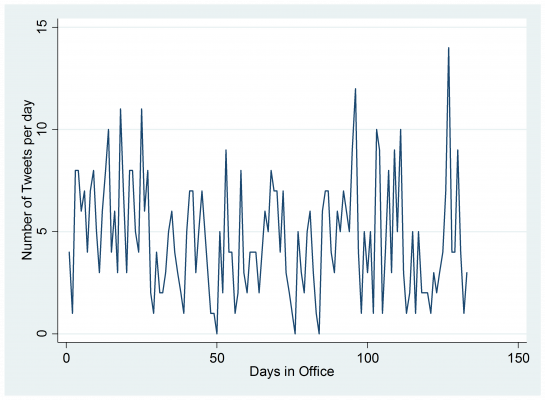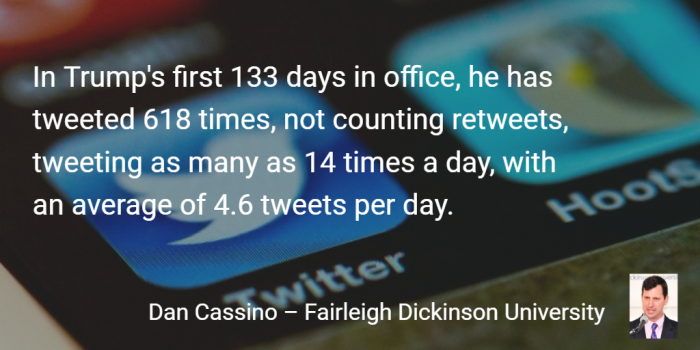 Presidential approval ratings are seen as critical to leveraging Congress, and are therefore important to any President who wishes to achieve legislative reform. Traditionally, Presidents have experienced a ‘honeymoon’ of initially high approval ratings – President Trump has bucked this trend with unprecedentedly low approval ratings for a new President. In new analysis, Dan Cassino finds that each of Trump’s ‘tweetstorms’ is costing him nearly one approval point each, indicating that his poor approval ratings are rather self-inflicted.
Presidential approval ratings are seen as critical to leveraging Congress, and are therefore important to any President who wishes to achieve legislative reform. Traditionally, Presidents have experienced a ‘honeymoon’ of initially high approval ratings – President Trump has bucked this trend with unprecedentedly low approval ratings for a new President. In new analysis, Dan Cassino finds that each of Trump’s ‘tweetstorms’ is costing him nearly one approval point each, indicating that his poor approval ratings are rather self-inflicted.
Part of the conventional wisdom about Donald Trump’s presidency – to the extent that there is any conventional wisdom – is that his tweeting is a distraction from the real issues that he could or should be dealing with. The second highest ranking member of the Republican Party in the Senate, John Cornyn of Texas, has said that Trump’s “Twitter habit” has “created problems” for the President. Even one of his top advisors, Kellyanne Conway has decried the media’s “obsession” with covering the President’s tweets. However, Trump himself has argued that Twitter is a better way to get his message to the public, as it doesn’t rely on what he views as the “dishonest” news media. As Trump approaches five months in office, though, there is now evidence that his tweeting is hurting his chances of accomplishing real legislative success.
A president’s leverage over the Congress is generally a function of his approval ratings: a president with high approval ratings can push members of Congress to do things that they otherwise would not do, either to gain the approval of a popular figure, or to avoid his wrath. Presidents with low approval numbers, on the other hand, often have trouble getting members of Congress to pay attention to their issue agenda, or act on their preferred legislation – think of President George W. Bush’s ill-fated attempts to push Social Security and immigration reform through in his troubled second term. By any standard, Trump has terribly low approval ratings: he seems to be the first President in the modern era to not have a significant ‘honeymoon’ – a period during his first three months in office during which he enjoys relatively high approval ratings. In the Gallup daily tracking poll, he started with 45 percent approval, and 45 percent disapproval; by his 100th day in office, his approval had fallen to 42 percent, while his disapproval climbed to 54 percent, an approval margin of -12. In contrast, Clinton had a margin of +18, George W. Bush +33, and Obama +36. These figures are also in spite of a strong economy, and low unemployment rates. It should be no surprise, given these figures, that Trump has lagged behind other recent Presidents in the passage of major legislation early in his first term, with Obamacare repeal languishing in the Senate, and his promised tax reform bill not yet introduced in the Congress.
Of course, one of the big differences between Trump and his predecessors in office is his use of Twitter. As can be seen in Figure 1, in his first 133 days in office, he has tweeted 618 times, not counting retweets, tweeting as many as 14 times a day, with an average of 4.6 tweets per day. Sometimes these tweets are relatively innocuous, pointing followers towards interviews, but others attract controversy, such as his recent tweets attacking the Mayor of London for telling citizens to stay calm in the wake of a terrorist attack, or his insistence that his executive action on immigration amounts to a “travel ban” despite claims by Administration lawyers that it is not. On average, about once a week, he has what might be regarded as a high use of Twitter day, in which he tweets more than seven times – there have been 22 such days since he took office.
Figure 1. Number of President Trump’s tweets while in office
But are these tweets really hurting his ability to pass legislation, by hindering his approval rating? Only in the past few weeks has Trump been in office long enough to potentially gauge their effect, and the results are not good for Trump. On the 17 percent of days when Trump goes on a tweetstorm of more than 7 tweets in a day, his margin of approval in the Gallup daily tracker (controlling for the three-day moving average structure of the Gallup data) falls by 0.86 points the following day. Twitter rants may be cathartic for the President, but every time he does it, he’s costing himself nearly a point in the margins – representing an increase in disapproval, or a decrease in approval. It’s possible, of course, that there are other event that both lead Trump to tweet, and hurt his approval ratings the following day, but the events that would seem likely to hurt his approval, such as his firing of FBI Director James Comey, don’t match up with the days on which he sends the most tweets.

Of course, these Twitter rants aren’t the only reason for Trump’s low approval ratings – he’s a uniquely controversial figure in American politics, and he’s shown little interest in winning over Americans that were initially opposed to his candidacy or issue positions. But this statistical evidence is the strongest case yet that Trump’s low approval ratings are partly a result of his use of Twitter, and that his approval problem, as Senator Cornyn said, is self-inflicted.
“Twitter” by Tom Raftery is licensed under CC-BY-NC-SA-2.0
Please read our comments policy before commenting.
Note: This article gives the views of the author, and not the position of USAPP – American Politics and Policy, nor the London School of Economics.
Shortened URL for this post: http://bit.ly/2rqrS1Y
_________________________________
 Dan Cassino – Fairleigh Dickinson University
Dan Cassino – Fairleigh Dickinson University
Dan Cassino is an associate professor of Political Science at Fairleigh Dickinson University in Madison, New Jersey, who studies political psychology and polling. His most recent book is “Fox News and American Politics,” and his forthcoming book, “Social Research Methods by Example: Applications in the Modern World,” with Yasemin Besen-Cassino, will be released in July, 2017.






